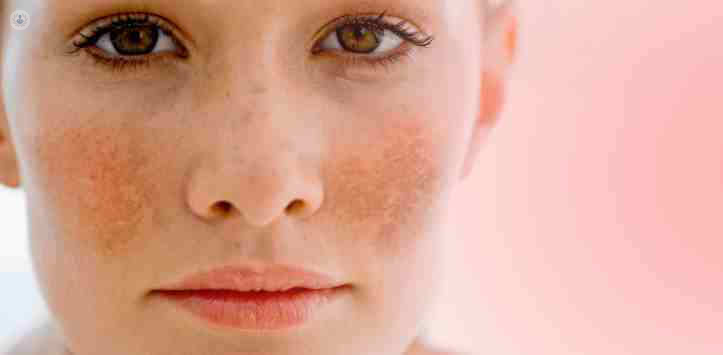

What is melasma?
Melasma, also known as cholasma, is a skin condition where patches of skin on the face take on a light or dark brown colour. It’s more noticeable in the summer, because these patches tend to tan more than the parts which are not affected. Melasma is a common condition, affecting women much more than men , and women who are pregnant in particular.

Is melasma a serious condition?
Melasma is not contagious, and it doesn’t develop into skin cancer or other health conditions. However, there is no cure for melasma, though there are a number of treatments (see below). If melasma occurs during pregnancy, the condition is likely to disappear again after a few months.
Symptoms of melasma
Melasma appears as darker patches of the face, usually the cheeks and nose. Patches might be small at first but grow larger over time. Unlike moles, they are flat, not raised. In some cases, you might get patches of dark skin on the neck and arms.
There is no itchiness or soreness, or any pain from melasma – the only symptom is the cosmetic difference it makes to your skin.
Medical tests to diagnose melasma
Melasma is usually straightforward to diagnose simply by looking at the pigmentation of the skin and the pattern made by the patches. In some cases, however, a dermatologist might recommend taking a small sample of skin to examine. This operation should be quick and will involve the use of local anaesthetic.
What are the causes of melasma?
What causes melasma is unknown. However, there are a lot of things that can increase your chances of developing the condition:
- having a darker skin type
- pregnancy
- use of contraceptive medication
- a family history of the condition
- sun exposure
Treatments for melasma
There is a certain amount that you can do yourself to manage melasma and improve the appearance of your skin. A dermatologist can also offer some options for treatment if these strategies haven’t worked.
What can I do?
- Protect yourself from the sun – sun protection is important not only to manage melasma but to reduce your chances of developing skin cancer. You can reduce your exposure to the sun by using a high-factor suncream (30 and above), wearing a hat when it’s sunny outside, and avoiding the use of tanning salons.
- Skin lightening creams – some skin lightening creams can be purchased over the counter, but might not be as effective as those prescribed by a dermatologist (see below).
- Cover-up makeup – some brands of makeup are designed to cover up darker marks, and you might be able to get a recommendation from a dermatologist.
What can a dermatologist offer?
- Prescription skin-lightening creams – these often contain a chemical called hydroquinone which prevents skin cells from producing melanin. There are side effects to the use of this cream, including skin irritation, and it does not work for everyone, so you can only get this cream on prescription from a doctor.
- Surgical procedures – a number of procedures can treat melasma, including microneedling, chemical peels, and laser therapy. Each type of procedure has associated risks and could make the condition worse, so it should be performed by an experienced specialist.
- Skin camouflage – a skin camouflage service can provide a cream that matches your skin type and covers up any dark patches on your skin. There are around 80 skin camouflage clinics in the UK offering advice and skin products for a range of skin conditions.
